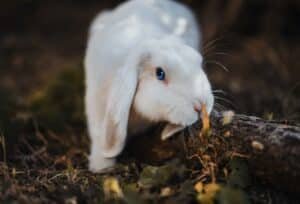Curious about rabbits with long hair like the Angora and Jersey Wooly? This guide covers the top breeds, their care, and grooming tips to keep their fur in top condition.
Key Takeaways
-
The most popular long-haired rabbit breeds include English Angora, French Angora, German Angora, Jersey Wooly, and Satin Angora, each requiring specific grooming and care.
-
Regular grooming is essential for long-haired rabbits to prevent matting, skin infections, and health issues such as wool block and gastrointestinal stasis.
-
A balanced diet of hay, pellets, and fresh vegetables is crucial for maintaining the health and coat quality of long-haired rabbits, alongside regular veterinary care.
Popular Long-Haired Rabbit Breeds
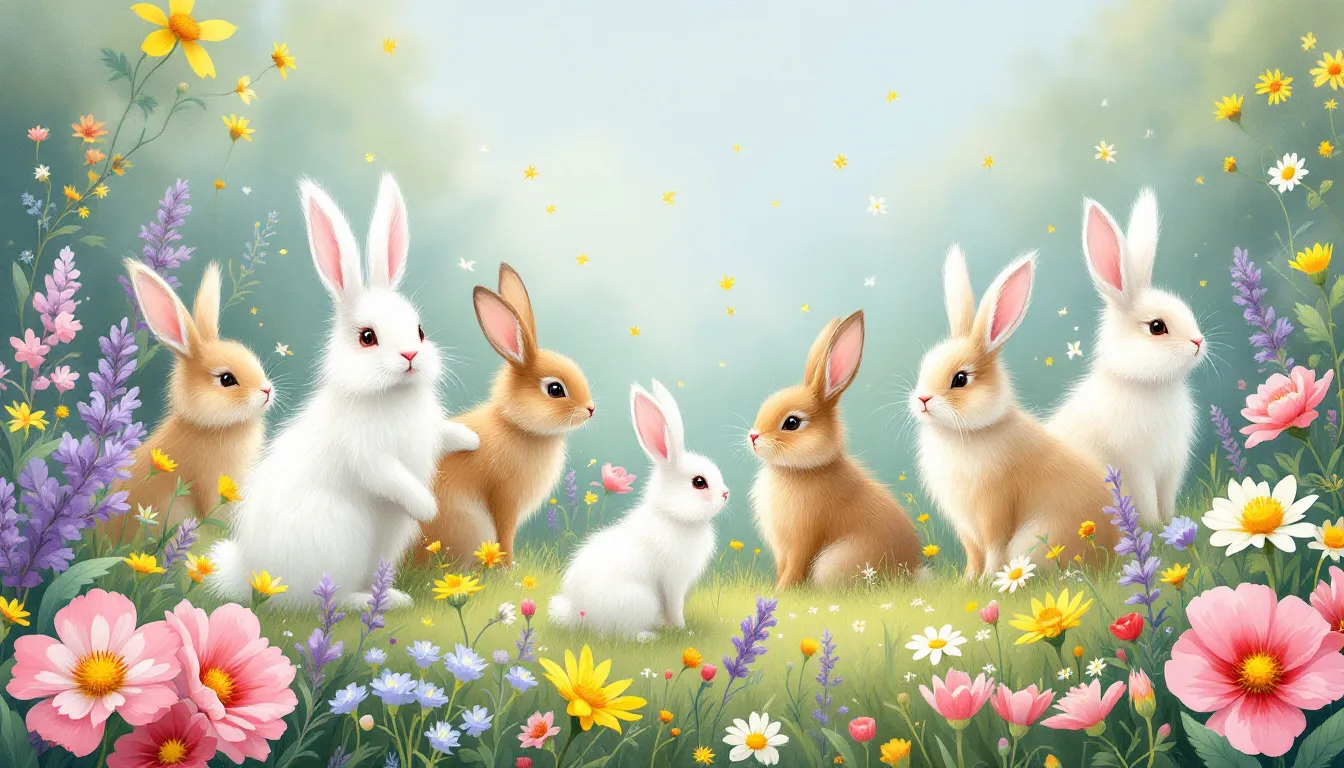
Long-haired rabbits are not only beautiful but also diverse in their characteristics and care needs. Among the most popular breeds are the English Angora, French Angora, German Angora, Jersey Wooly, and Satin Angora. Each of these breeds has unique features, from the dense, luxurious fur of the English Angora to the shiny, silky coat of the Satin Angora, making them ideal companions for those who appreciate a long-haired bunny. The Angora rabbit originated from Ankara, Turkey, and was bred for its long fibers known as Angora wool.
Knowing the specific needs and traits of these smaller breeds helps in offering the best care possible.
English Angora
The English Angora is renowned for its incredibly dense fur, which covers even the ears and face, giving it a distinctive appearance. Daily grooming prevents matting and keeps their angora wool soft.
Routine brushing and attentive care are necessary to keep their brushed coat healthy and beautiful. While they are a joy to behold, English Angoras demand a dedicated grooming routine to maintain their dense fur.
French Angora
The French Angora is noted for its larger size and fluffy coat, making it a striking breed among long-haired rabbits. Regular grooming keeps their coats healthy, prevents matting, and ensures their fur remains clean and soft.
This breed’s grooming needs are slightly less intensive than the English Angora, but consistent care is still necessary to keep them comfortable and healthy.
German Angora
German Angoras are prolific wool producers, generating more wool than other rabbit breeds. Frequent shearing and grooming are necessary to manage their abundant coats and prevent issues like matting and wool block. Grooming long-haired rabbits should be done several times a week to prevent matting.
Regular grooming sessions are necessary for German Angoras to manage their fur and ensure their comfort and health. It is important to groom them regularly.
Jersey Wooly
Jersey Wooly rabbits are distinguished by their soft fur and short facial hair, which simplifies grooming compared to other breeds. Their long, soft body fur requires regular care to prevent tangling, but their shorter facial hair means less frequent grooming in that area. The jersey woolly is a notable example of this breed’s unique characteristics.
Known for their cute appearance, Jersey Woolies have manageable grooming needs.
Satin Angora
The Satin Angora stands out for its shiny, soft fur that glistens when the coat is parted. Medium-sized with long, erect ears, this breed requires frequent grooming to maintain the sheen and prevent tangling and matting of their fur. Additionally, Angora wool has fewer allergy-causing qualities compared to other types of animal wool.
Satin Angoras are relatively low-maintenance compared to other long-haired rabbits, but regular grooming keeps their coats in pristine condition.
Grooming Tips for Long-Haired Rabbits
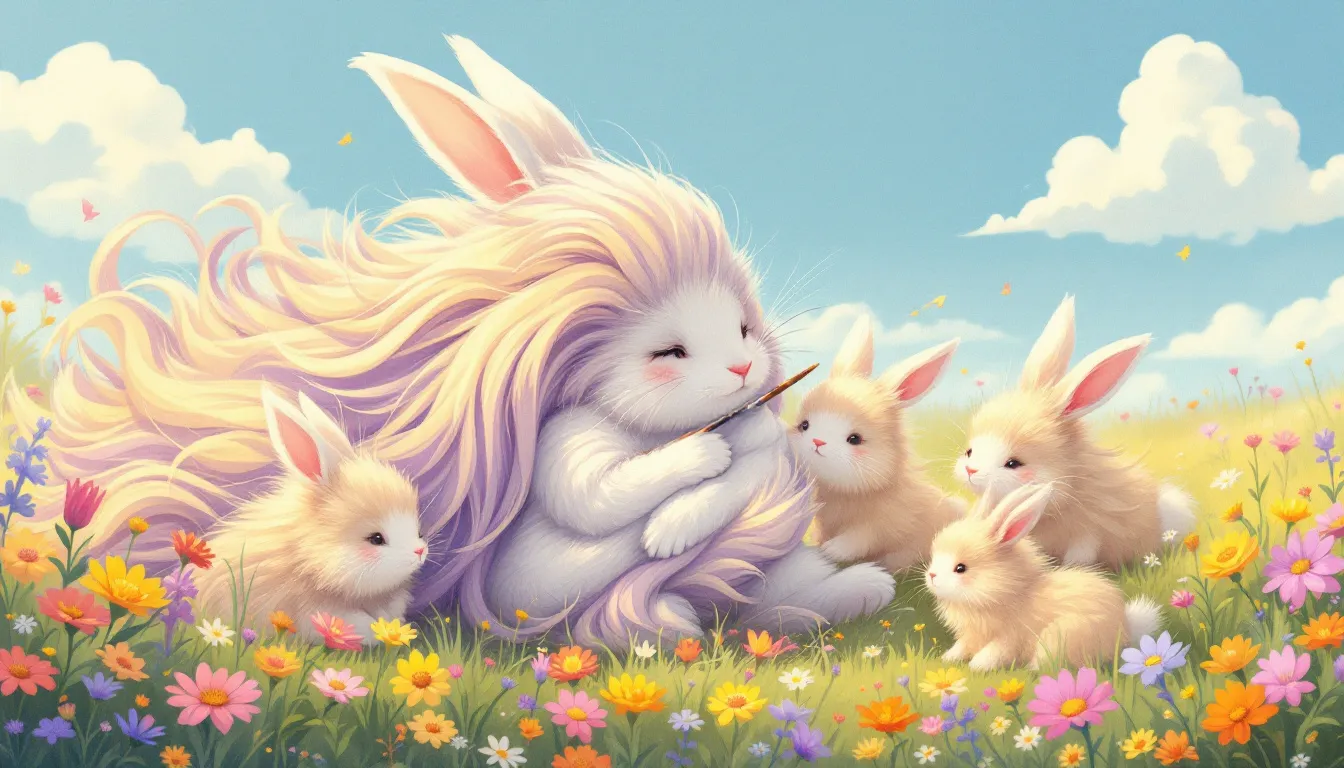
Grooming long-haired rabbits is a vital part of their care routine. Regular grooming helps prevent matting, reduces the risk of skin infections, and keeps their coats healthy and beautiful. Key grooming practices include regular brushing, proper shearing techniques, and nail trimming.
Each of these practices requires specific tools and methods to ensure the rabbit’s comfort and well-being.
Regular Brushing
Long-haired rabbits should be groomed daily to prevent issues like matting and discomfort. Areas prone to tangling include under the chin, back of the neck, under the arms, around the tail, and groin. A wide-toothed comb effectively detangles their fur.
If daily combing isn’t feasible, keeping the coat short can prevent mats. Breaks during grooming sessions allow the rabbit to use the litter box and reduce stress.
Shearing Techniques
Maintaining a long-haired rabbit’s health and appearance requires proper shearing techniques. Begin with clean, dry fur and work in small sections to avoid cutting the skin. Necessary tools include specialized rabbit clippers, pet grooming scissors, and a fine-toothed comb. Always be gentle around sensitive areas such as the ears and tail, and check the skin for any cuts or irritations after shearing. Curved scissors with blunt tips should be used to reduce the risk of cutting the rabbit’s skin during grooming.
Nail Trimming
Regular nail trimming is crucial for long-haired rabbits. Positioning the rabbit on a high, stable surface like a countertop can simplify the process. Using a flashlight to illuminate the nails makes it easier to see the quick and avoid cutting it.
Flipping the rabbit onto its back can help keep it calm and still. Gentle handling and a secure hold are essential to make the process smoother.
Health Issues in Long-Haired Rabbits
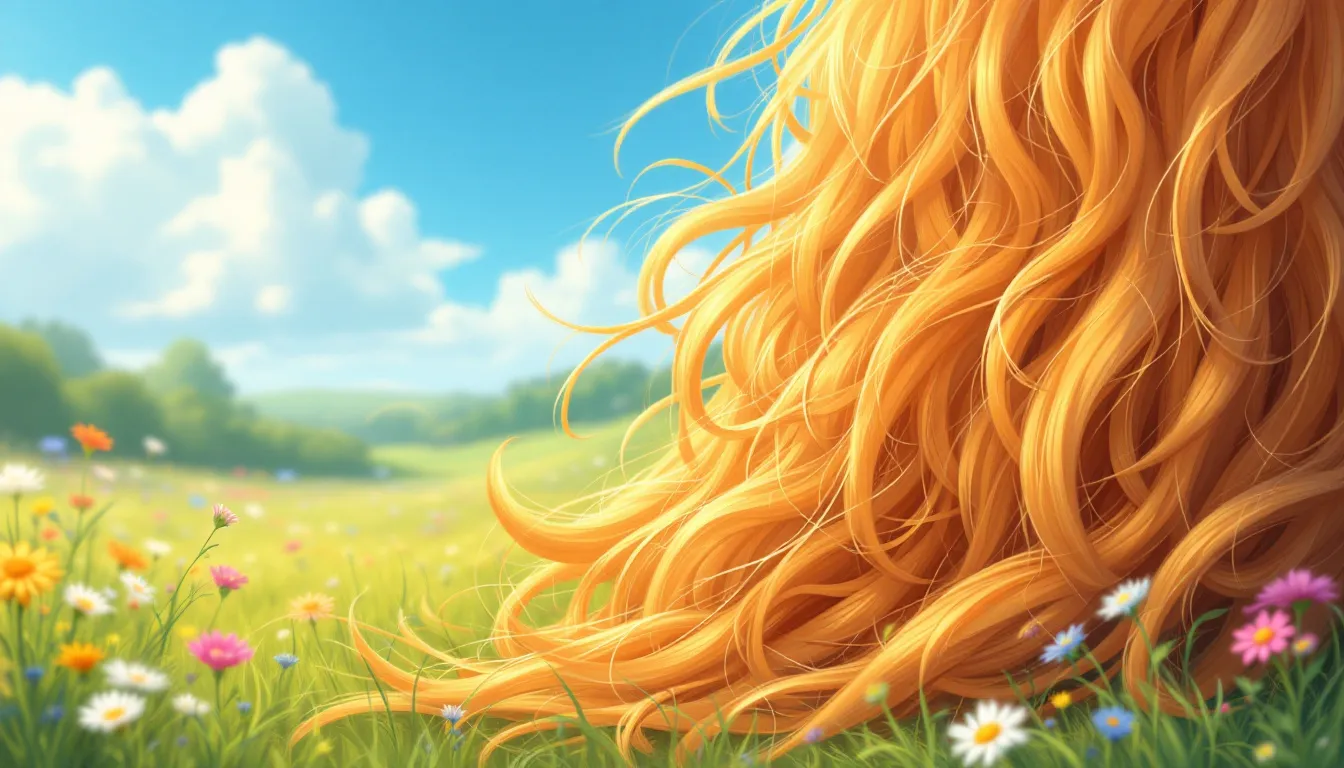
Long-haired rabbits are prone to health issues such as gastrointestinal stasis, wool block, and skin infections. These conditions can be serious and require prompt attention and preventive measures.
Knowing these health risks and how to address them is crucial for any long-haired rabbit owner.
Gastrointestinal Stasis
Gastrointestinal stasis occurs when the passage through the rabbit’s digestive tract slows or stops. Chronic ingestion of hair can cause gastric stasis, potentially requiring surgical treatment if severe. Symptoms include loss of appetite and lethargy, and immediate veterinary attention is critical.
Wool Block
Wool block occurs when long-haired rabbits ingest their fur during grooming, leading to severe health issues. This can lead to gastrointestinal stasis. Preventing wool block involves regular grooming to reduce loose hair and providing a high-fiber diet.
Regular grooming sessions minimize the risk of wool block and keep the rabbit healthy.
Skin Infections
Matted fur can trap moisture and feces, increasing the risk of skin infections like fly strike, where flies lay fly eggs on moist mat areas in cats, affecting the skin underneath a bit. This condition requires shaving and veterinary treatment to manage the infection in the shed as mats form. When fly eggs hatch, it can worsen the situation. Flystrike can occur in unkempt, long-haired rabbits with messy bottoms, leading to severe health issues.
Regular grooming prevents mats and reduces the risk of skin infections when groomed regularly with a brush.
Feeding Requirements for Long-Haired Rabbits

A balanced diet is crucial for the health of long-haired rabbits. Their diet should include hay, pellets, and fresh vegetables to support their digestive health and maintain their luxurious coats. Proper nutrition prevents health issues such as wool block and gastrointestinal stasis.
Hay and Pellets
Hay, the primary component of their diet, provides essential fiber to keep the digestive system healthy. They should be offered a pile of hay at least the size of their body twice a day or more.
Pellets should supplement their diet in moderation, with 1/4 cup per 4–5 pounds of rabbit per day being the recommended amount.
Fresh Vegetables
Fresh vegetables provide vitamins and support fur growth, making them a crucial part of the diet. Leafy greens such as romaine, red leaf lettuce, and herbs like parsley and basil are ideal for daily feeding. Vegetables like spinach and broccoli should be offered in moderation due to their starch content.
Fresh vegetables should constitute 15-20% of their diet, with portions around 2 cups for every 6 pounds of rabbit.
Treats
Treats should be high in fiber and low in fat or sugar to promote their health. High-fiber, low-fat treats are the best options to eat for maintaining their overall health.
Healthy treats ensure long-haired bunnies get necessary nutrients without unhealthy additives, playing a key role in a balanced diet.
Behavioral Traits of Long-Haired Rabbits
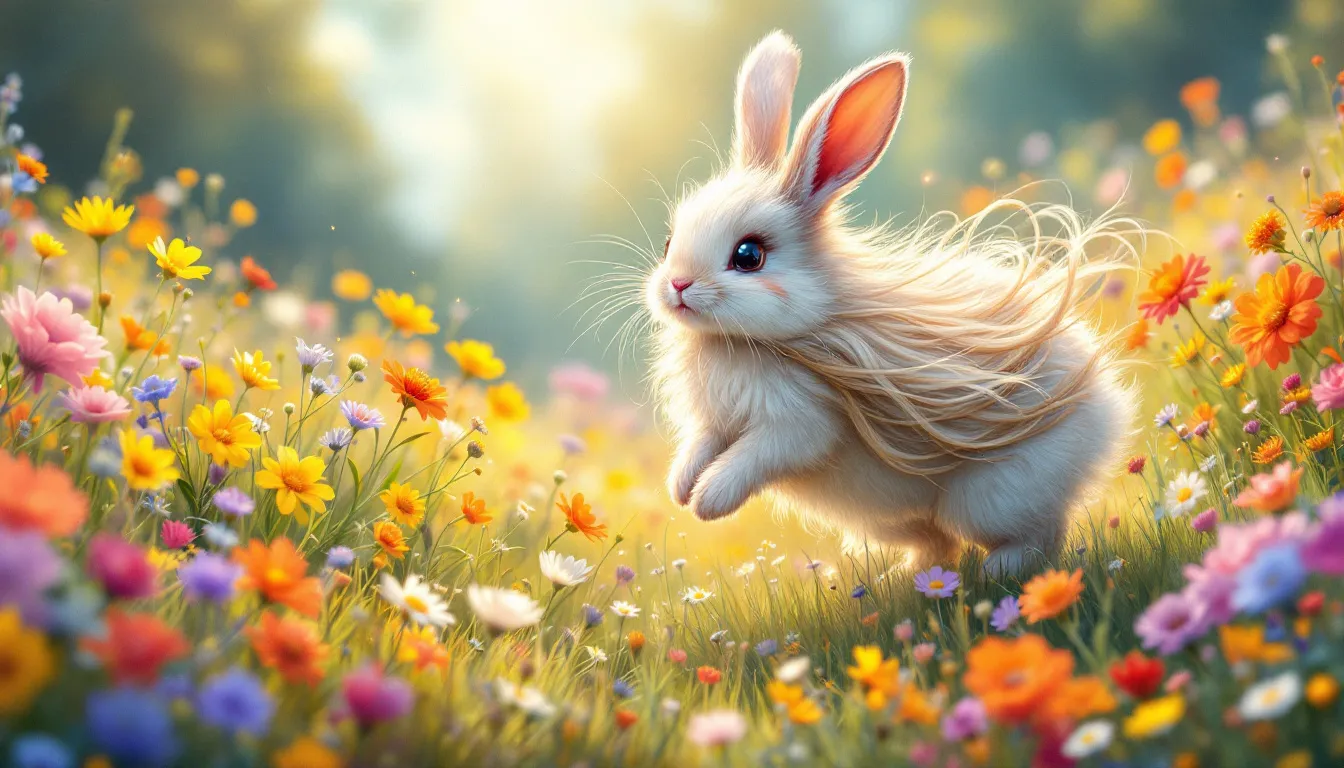
Knowing the behavioral traits of long-haired rabbits aids in providing better care and fostering a strong bond with the owner. Angoras and other long-haired breeds are known for their gentle, sensitive nature, making them prone to stress but also very affectionate.
Social Nature
Angora rabbits thrive on frequent interaction and play. Male and female Angoras both display affectionate and sociable behavior toward humans and other pets, much like a bunny.
While they enjoy cuddle time, they typically do not like being picked up, preferring to interact on their own terms.
Training
Intelligent and quick to grasp basic commands, Angora rabbits can be trained effectively. With positive reinforcement, they can learn to respond to their names and use a litter box effectively. Regular training reinforces good behavior and strengthens the bond between rabbit and owner.
Handling
Gentle handling prevents Angora rabbits from becoming frightened and potentially injured. Support their hind legs and body when holding to avoid harm.
Careful handling ensures that these thin, delicate animals remain comfortable and safe.
Special Considerations for Long-Haired Rabbit Owners
Owning a long-haired rabbit, especially an Angora, requires a commitment to their unique needs. These beautiful rabbits demand extra time and care to maintain their health and appearance, particularly if they have long hair. Angora rabbits originated in Ankara, Turkey.
Knowing these special considerations helps in providing the best care.
Time Commitment
Caring for an Angora rabbit involves daily grooming, including brushing and trimming their long fur to prevent matting. This routine can be time-consuming, taking up to an hour a week, depending on the coat’s condition and shedding.
Daily interaction and exercise are also essential for their well-being.
Veterinary Care
Regular veterinary visits are essential for maintaining the health of Angora rabbits. Routine visits typically cost between $35 and $65, with initial costs for spaying or neutering ranging from $125 to $250. They help prevent health issues and ensure the rabbit receives appropriate care.
Suitable Environment
Angora rabbits require ample space to move and play, thriving on social interaction with both humans and other rabbits. They can live indoors or outdoors, but a secure hutch is necessary for outdoor living.
Rabbit-proofing the living space prevents damage and ensures safety.
Summary
Long-haired rabbits, with their enchanting appearance and gentle nature, are a joy to own but require dedicated care. From understanding the unique characteristics of breeds like the English Angora and Satin Angora to implementing regular grooming routines, each aspect of care is crucial for their well-being. Feeding them a balanced diet rich in hay, pellets, and fresh vegetables supports their health, while being aware of potential health issues like gastrointestinal stasis and wool block ensures prompt action when needed. Additionally, recognizing their social behaviors and training effectively enhances the bond between owner and pet. Ultimately, the commitment to time, grooming, and veterinary care is rewarded with the affectionate companionship of these charming rabbits. Embrace the journey of caring for a long-haired rabbit, and enjoy the unique bond that comes with it.
Frequently Asked Questions
How often should I groom my long-haired rabbit?
Daily grooming is essential for long-haired rabbits to prevent matting and ensure their coat remains healthy. Regular maintenance helps keep your pet comfortable and looking its best.
What is gastrointestinal stasis, and how can I prevent it in my rabbit?
Gastrointestinal stasis is a serious condition in rabbits caused by slowed or halted digestion. To prevent it, ensure your rabbit has regular grooming, a high-fiber diet and seek veterinary care immediately if symptoms arise.
What kind of diet is best for long-haired rabbits?
A balanced diet for long-haired rabbits should primarily consist of hay, with pellets provided in moderation and fresh vegetables making up about 15-20% of their diet. Ensuring this balance is essential for their health and well-being.
How do I handle my Angora rabbit to avoid injury?
To avoid injury when handling your Angora rabbit, support both its hind legs and body gently while ensuring it feels secure and comfortable. This approach minimizes the risk of injury and helps build trust between you and your rabbit.
What are the costs associated with veterinary care for Angora rabbits?
Veterinary care for Angora rabbits generally incurs costs of $35 to $65 for routine visits, while spaying or neutering can range from $125 to $250. Regular veterinary check-ups and procedures are essential for maintaining their health.

